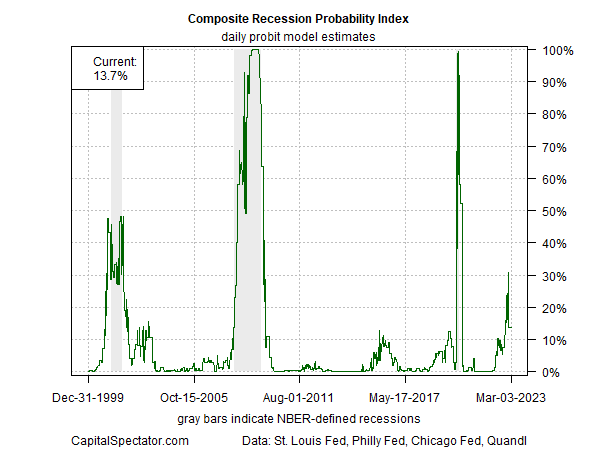US recession risk is high unless it’s not. After months of conflicting signals from various business-cycle indicators, debate and disagreement reign supreme in the land of nowcasting and forecasting the odds for an economic downturn. In other words, the value of combination forecasting in the current environment has rarely been higher.
As a quick recap, researchers for decades have documented the power of combining forecasts from several models – ideally with substantially different methodologies and data sets – for improving ex-ante estimates. The original research that formally documented this technique was published in 1969 for the task of forecasting airline passenger data. There’s been a firehose of follow-up studies ever since. The main takeaway: forecasting is hard, but almost every effort to project data benefits by combining estimates from several models.
The evidence is clear: forecasting errors are usually smaller through time with ensemble forecasts vs. single-model estimates. There’s no magic bullet here. All forecasts are wrong, even if luck sometimes prevails and delivers perfect estimates. But the future’s still uncertain. Dead stop. But by combining forecasts and aggregating information and methodologies, the range of error tends to shrink.
Keeping this empirical truth in mind has been helpful in recent months as different methods for nowcasting and forecasting US recession risk has offered sharply conflicting views. From inverted yield curves to deeply negative leading economic indexes, there’s been a striking rise in macro warning signs.
Yet the economy didn’t get the memo. Payrolls surged in January and topped estimates over the past ten months as consumer spending rebounded sharply last month. The strength could quickly reverse, and some indicators imply they will. But for the moment, the rearview mirror is clear: the US economy has not fallen into recession, even though some metrics suggest otherwise. The current nowcast for first-quarter GDP suggests more of the same is on tap for the immediate future, or at least according to one econometric view (that should be viewed cautiously): the Atlanta Fed’s GDPNow model’s March. Seven nowcast sees Q1 output rising a respectable 2.1%.
What went wrong with all the dark warnings? The lesson starts by remembering that any one measure or model of economic activity isn’t flawless. It’s easy to forget this lesson, an oversight supported by selectively looking at historical indicators. But even when a metric or technique enjoys a track record of flawless or near-flawless results, that’s still no pass on, ignoring the power of using combination forecasts as a reality check.
One quick example: Several business-cycle indicators, including a pair of proprietary metrics, from roughly mid-October to the present, several have been warning of trouble. The main exception is the signature combination indicator, which aggregates multiple business-cycle indicators from various sources into one real-time probability estimate of recession risk.

The Composite Recession Probability Index (CRPI) has yet to signal a high-probability estimate that an NBER-defined contraction has started. Although CRPI spiked recently, it topped out at roughly a 30% probability and has pulled back in the past couple of weeks.
Granted, even combination forecasts can and will be wrong to some degree. That’s the nature of all forecasting. But the crucial distinction is that ensemble forecasts are likely less wrong than single-model or single-indicator estimates. That’s no silver bullet, but it’s usually the least-worst way to nowcast and forecast.
